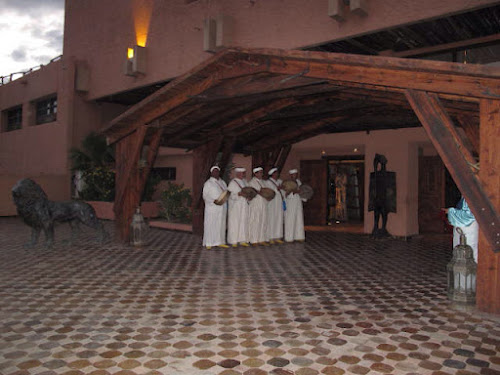We drive to Volubilis to see the Roman ruins. This city was active from 45-285 AD. The population was 20,000. They exported olives and wheat to Rome and also supplied the gladiator fighting lions. There are no more lions in Morocco.
Below photo shows the butcher shop as you can see by the head of the cow on the pillar.
Our Tour Director, Andrew Simon, was outstanding as was his local colleague, Mohammed Salmi, from Meknes, Morocco. The National Geographic expert, Jeffrey Taylor, had been a Peace Corps volunteer in Morocco, as mentioned, and has taken two serious lengthy trips exploring Morocco, so is very knowledgeable about the country. We enjoyed the different insights of all three of these leaders. In each city we had local guides and they were all very good and spoke English very well. It was also a good mix of people in the group, 19 women and 7 men, ranging in age from early 20's to 87 plus our three leaders, all men.
We learned a tremendous amount about the country of Morocco, the people, the culture and the beautiful handcrafts and artifacts. Morocco was the first country to recognize the United States of America after we gained our independence from Great Britain in the 18th century, so our ties go way back. We were sorry to learn that Morocco has an illiteracy rate of 45%. The country has made strides under the current King, Mohammed VI, but it has a ways to go. It seems to be way ahead of the other North Africa countries and has remained somewhat stable. We hope that Morocco will continue to progress. The Moroccans often say, inshallah, meaning "God willing", and that is an appropriate comment here.
We were also glad that we were able to visit Portugal and Spain along with Morocco as their histories and cultures have been intertwined for centuries. Our Tauck tour of the Iberian peninsula was as equally excellent as the National Geographic Tour of Morocco. Our Tauck leader, Patricia Hunting, was terrific. I am sorry that I did not get the blog written for the first tour as I was just learning how to create a blog, had limited use of wifi and had limited time. We also enjoyed our week in between the two tours sightseeing and relaxing on our own, a necessary respite, as well as connecting with our Toronto friends both in Madrid and Barcelona. Interestingly we made special friends on each of the two tours with couples from Australia. That may be a future destination! We feel very fortunate to have been able to make this journey and we are grateful to our daughter Caroline who kept our home fires burning and covered our local commitments. As always, we are glad to be home!














































